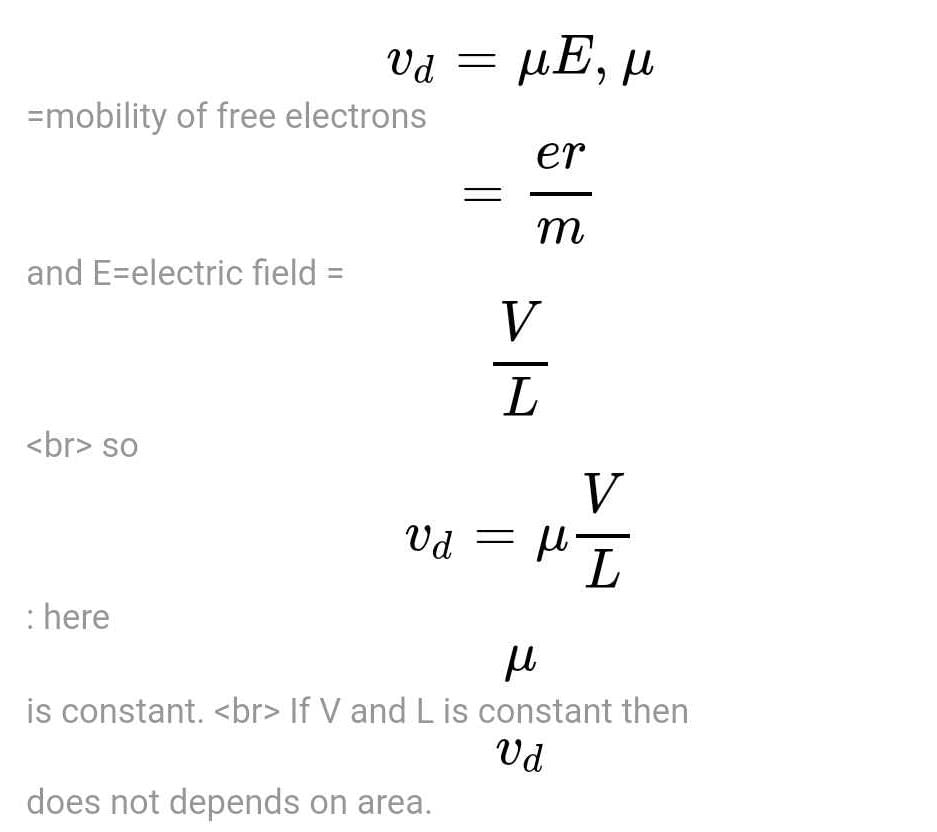NEET Exam > NEET Questions > A constant voltage is applied across a wire o...
Start Learning for Free
A constant voltage is applied across a wire of constant length. How does the drift velocity of electrons depends on the area of cross section of wire.?
Most Upvoted Answer
A constant voltage is applied across a wire of constant length. How do...

Community Answer
A constant voltage is applied across a wire of constant length. How do...
Dependence of Drift Velocity on Cross-Sectional Area of Wire
When a constant voltage is applied across a wire of constant length, an electric field is produced in the wire. This electric field applies a force on the free electrons present in the wire, causing them to drift towards the positive end of the wire. The drift velocity of these electrons is dependent on several factors, including the cross-sectional area of the wire.
Inverse Relationship
The drift velocity of electrons in a wire is inversely proportional to the cross-sectional area of the wire. This means that as the cross-sectional area of the wire increases, the drift velocity of electrons decreases, and vice versa.
Explanation
The reason for this inverse relationship is that as the cross-sectional area of the wire increases, the number of free electrons in the wire also increases. This increased number of electrons means that there is less resistance to the flow of current, which leads to a decrease in the electric field and, consequently, a decrease in the drift velocity of electrons.
Conversely, as the cross-sectional area of the wire decreases, there are fewer free electrons in the wire, which increases the resistance to the flow of current. This increased resistance leads to a higher electric field and, consequently, a higher drift velocity of electrons.
Conclusion
The relationship between the drift velocity of electrons and the cross-sectional area of the wire is an important concept in understanding the behavior of electric currents. By understanding this relationship, we can design wires of the appropriate dimensions to achieve the desired level of current flow for a given application.
Attention NEET Students!
To make sure you are not studying endlessly, EduRev has designed NEET study material, with Structured Courses, Videos, & Test Series. Plus get personalized analysis, doubt solving and improvement plans to achieve a great score in NEET.

|
Explore Courses for NEET exam
|

|
Similar NEET Doubts
A constant voltage is applied across a wire of constant length. How does the drift velocity of electrons depends on the area of cross section of wire.?
Question Description
A constant voltage is applied across a wire of constant length. How does the drift velocity of electrons depends on the area of cross section of wire.? for NEET 2024 is part of NEET preparation. The Question and answers have been prepared according to the NEET exam syllabus. Information about A constant voltage is applied across a wire of constant length. How does the drift velocity of electrons depends on the area of cross section of wire.? covers all topics & solutions for NEET 2024 Exam. Find important definitions, questions, meanings, examples, exercises and tests below for A constant voltage is applied across a wire of constant length. How does the drift velocity of electrons depends on the area of cross section of wire.?.
A constant voltage is applied across a wire of constant length. How does the drift velocity of electrons depends on the area of cross section of wire.? for NEET 2024 is part of NEET preparation. The Question and answers have been prepared according to the NEET exam syllabus. Information about A constant voltage is applied across a wire of constant length. How does the drift velocity of electrons depends on the area of cross section of wire.? covers all topics & solutions for NEET 2024 Exam. Find important definitions, questions, meanings, examples, exercises and tests below for A constant voltage is applied across a wire of constant length. How does the drift velocity of electrons depends on the area of cross section of wire.?.
Solutions for A constant voltage is applied across a wire of constant length. How does the drift velocity of electrons depends on the area of cross section of wire.? in English & in Hindi are available as part of our courses for NEET.
Download more important topics, notes, lectures and mock test series for NEET Exam by signing up for free.
Here you can find the meaning of A constant voltage is applied across a wire of constant length. How does the drift velocity of electrons depends on the area of cross section of wire.? defined & explained in the simplest way possible. Besides giving the explanation of
A constant voltage is applied across a wire of constant length. How does the drift velocity of electrons depends on the area of cross section of wire.?, a detailed solution for A constant voltage is applied across a wire of constant length. How does the drift velocity of electrons depends on the area of cross section of wire.? has been provided alongside types of A constant voltage is applied across a wire of constant length. How does the drift velocity of electrons depends on the area of cross section of wire.? theory, EduRev gives you an
ample number of questions to practice A constant voltage is applied across a wire of constant length. How does the drift velocity of electrons depends on the area of cross section of wire.? tests, examples and also practice NEET tests.

|
Explore Courses for NEET exam
|

|
Suggested Free Tests
Signup for Free!
Signup to see your scores go up within 7 days! Learn & Practice with 1000+ FREE Notes, Videos & Tests.

























